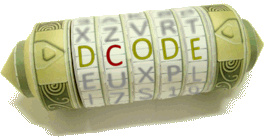Tool for calculating the value of the conjugate of a complex number. The conjugate of a complex number $ z $ is written $ \overline{z} $ or $ z^* $ and is formed of the same real part with an opposite imaginary part.
Complex Number Conjugate - dCode
Tag(s) : Geometry
dCode is free and its tools are a valuable help in games, maths, geocaching, puzzles and problems to solve every day!
A suggestion ? a feedback ? a bug ? an idea ? Write to dCode!
Complex Number Conjugate
Complex Conjugate Calculator
Answers to Questions (FAQ)
What is the conjugate of a complex number? (Definition)
The conjugate of a complex number $ z = a+ib $ is noted with a bar $ \overline{z} $ (or sometimes with a star $ z^* $) and is equal to $ \overline{z} = a-ib $ with $ a = \Re (z) $ the real part and $ b = \Im (z) $ the imaginary part.
In other words, the conjugate of a complex is the number with the same real part but with opposite imaginary part.
On a complex plane, the points $ z $ and $ \overline{z} $ are symmetrical (symmetry with respect to the x-axis).
How to calculate the conjugate of a complex number?
From the algebraic form of a complex number $ z = a+ib $, the conjugate is calculated $ \overline{z} = a-ib $.
Example: Determine the conjugate of $ z = 1+i $ is to calculate $ \overline{z} = 1-i $
In other words, to find the conjugate of a complex number, take that same complex number but with the opposite (minus sign) of its imaginary part (containing $ i $).
What is a complex conjugate pair?
The set of 2 elements: a complex number $ z $ and its conjugate $ \overline{z} $, form a pair of conjugates.
What are the properties of conjugates?
Using the complex numbers $ z, z_1, z_2 $, the conjugate has the following properties:
$$ \overline{z_1+z_2} = \overline{z_1} + \overline{z_2} $$
$$ \overline{z_1 \cdot z_2} = \overline{z_1} \times \overline{z_2} $$
$$ \overline{\left(\frac{z_1}{z_2}\right)} = \frac{\overline{z_1}}{\overline{z_2}} \iff z_2 \neq 0 $$
A number without an imaginary part is equal to its conjugate:
$$ \Im (z) = 0 \iff \overline{z} = z $$
The modulus of a complex number and its conjugate are equal:
$$ |\overline{z}|=|z| $$
What is the product of a complex number and its conjugate?
The multiplication of a complex number $ z = a + ib $ and its conjugate $ \overline{z} = a-ib $ gives: $$ z \times \overline{z} = a^2+b^2 $$
This number is a real number (no imaginary part $ i $) and strictly positive (addition of 2 squares values necessarily positive)
What is the conjugate of i?
The conjugate of the number $ i $ is the number $ -i $
How to calculate the conjugate of a real number (without i)?
The conjugate $ \overline{a} $ of a real number $ a $ is the number $ a $ itself: $ a=a+0i=a-0i=\overline{a} $
Example: $ \overline{1 + 0 \times i} = 1 $
Does the conjugate change the real part of a complex number?
The real part of a complex number always remains unchanged when calculating the conjugate. The real part never changes. $ \Re(z) = \Re(\overline{z}) $
Source code
dCode retains ownership of the "Complex Number Conjugate" source code. Any algorithm for the "Complex Number Conjugate" algorithm, applet or snippet or script (converter, solver, encryption / decryption, encoding / decoding, ciphering / deciphering, breaker, translator), or any "Complex Number Conjugate" functions (calculate, convert, solve, decrypt / encrypt, decipher / cipher, decode / encode, translate) written in any informatic language (Python, Java, PHP, C#, Javascript, Matlab, etc.) or any database download or API access for "Complex Number Conjugate" or any other element are not public (except explicit open source licence). Same with the download for offline use on PC, mobile, tablet, iPhone or Android app.
Reminder: dCode is an educational and teaching resource, accessible online for free and for everyone.
Cite dCode
The content of the page "Complex Number Conjugate" and its results may be freely copied and reused, including for commercial purposes, provided that dCode.fr is cited as the source (Creative Commons CC-BY free distribution license).
Exporting the results is free and can be done simply by clicking on the export icons ⤓ (.csv or .txt format) or ⧉ (copy and paste).
To cite dCode.fr on another website, use the link:
In a scientific article or book, the recommended bibliographic citation is: Complex Number Conjugate on dCode.fr [online website], retrieved on 2025-12-06,
- Complex Conjugate Calculator
- What is the conjugate of a complex number? (Definition)
- How to calculate the conjugate of a complex number?
- What is a complex conjugate pair?
- What are the properties of conjugates?
- What is the product of a complex number and its conjugate?
- What is the conjugate of i?
- How to calculate the conjugate of a real number (without i)?
- Does the conjugate change the real part of a complex number?
